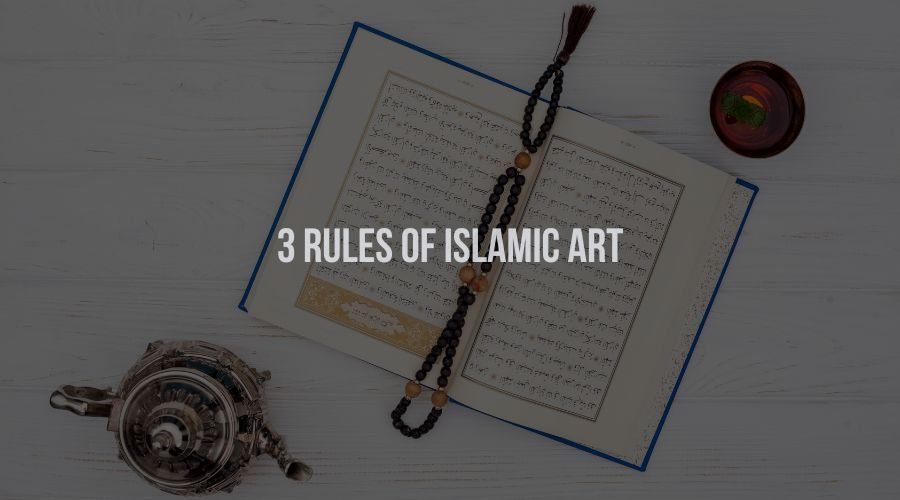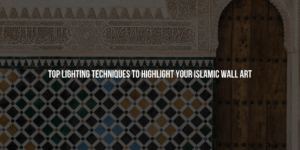Islamic art is beautiful and meaningful. It has pretty shapes, nice writing, and peaceful nature designs. It is more than just decoration. It uses a special way of expressing art that comes from strong belief and respect for the creation by a higher power. It has three main principles: believing in one God, wearing a veil, and receiving divine blessings. These principles are expressed in different ways and in many places. By understanding these guiding lights, we can appreciate the beauty of Islamic art not only on the surface but also on a spiritual level.
Tauhid
Islamic art is based on the idea of Tauhid, which means that there is only one God. It means that people believe only God can create and take care of things, and making pictures or statues of him would be like worshipping something that is not him. In Islamic art, there are no pictures of people or animals.
Artists use geometric patterns, detailed arabesques, and stylized natural forms to show the order and harmony in creation. These pictures represent God’s beauty and perfection. They make people think about God through precise shapes and natural patterns.
The Hagia Sophia has a big dome with star patterns. Mosques in Morocco have pretty tilework. They remind us of the divine hand that controls the universe.
Hijab
The hijab means “veil” and is about being modest and having inner beauty and spiritual depth. In Islamic art, the main idea is to have a simple and elegant style without being too flashy. Art is not just something to look at, but it helps us think and feel connected to something bigger.
People often choose colours that make them feel calm and thoughtful, like peaceful blues and greens, or natural browns and cosy yellows. Patterns are used to create a feeling of order and balance, instead of being too complicated. Art is beautiful because the artist is talented and the viewer can understand and enjoy the hidden messages in the art.
People who wear the Hijab show their dedication through beautiful Quranic writing, elegant carpets made by hand, and the way light and shadow work together in traditional buildings. These expressions ask us to look deeper and find the beauty and spiritual meaning in the art.
Baraka
Baraka is a special blessing or grace that gives Islamic art a strong sense of meaning. Islamic art is different from art that just looks nice. Islamic art wants to make you feel good and connected to something bigger. Every line, colour, and shape can have a special meaning and make the viewer feel good inside.
This principle means that verses from the Quran or Islamic proverbs are written in fancy writing. They are there to remind people about their faith and give them guidance. Architectural spaces are made for praying and thinking. They have things like qiblas and ablution fountains. Even simple things like pottery and textiles have pretty designs that remind us of how special everything is.
Islamic art encourages us to make our surroundings blessed by embracing Baraka. It tells us to enjoy the beauty of things made by God and use art to feel closer to God.
Thinking Outside the Box: An Artistic Space
These three principles, Tauhid, Hijab, and Baraka, are not strict rules but instead are guiding lights that show the way for Islamic art. In this system, artists have a lot of freedom to be creative. They can use different techniques and styles to show their ideas and beliefs.
Islamic art is always changing and showing the energy of Muslim communities. It includes different styles, from modern art by Dia Azzawi to old-fashioned miniature paintings from the Ottoman era.
If we understand these basic ideas, we can appreciate the deep meaning of Islamic art, even if we don’t have the same beliefs or artistic knowledge. We can learn to look deeper and explore the spiritual journey that each piece invites us to take. Let’s look at Islamic art with open hearts and minds, ready to be moved by its special way of showing faith and creativity.
Living with Islamic art
Exploring Islamic art is not just about going to museums or galleries. This is an invitation to accept its principles and incorporate its beauty and meaning into our lives. Here are some ways to change your personal space and daily experiences using these important pillars:
1. Practise Tauhid at home
Make a special place for praying or thinking. Decorate it with shapes, peaceful colours, or meaningful verses from the Quran. Remember that God is always with you by noticing the things around you.
2. The beauty of wearing a Hijab.
Wear simple clothes that show what you believe in and make you feel comfortable and peaceful. When decorating your home, focus on making things simple and beautiful, rather than showing off.
3. Find peace and blessings in everyday things.
Fill your surroundings with special things made by hand, like woven fabrics or clay pottery. When you use them, remember to appreciate the special blessing in each cup of tea or every meal you have with loved ones.
4. Islamic art.
Get involved with your community. Plan meetings to talk about the meaning of certain artworks. You can also learn calligraphy or make geometric patterns with others. Tell others what you know and like about Islamic art.
5. Embrace faith completely.
Use the principles of Islamic art to guide your artistic expression. Write a poem about the beauty of the Hijab, make music that sounds like the patterns on Hijabs, or create art with calligraphy or textiles.
Living with Islamic art is a continuous process of learning and exploring. It’s about taking care of your inner self, growing your beliefs, and showing what you care about through things that are beautiful and meaningful. Follow these principles to change your surroundings, interactions, and yourself into a beautiful example of harmony and grace.


